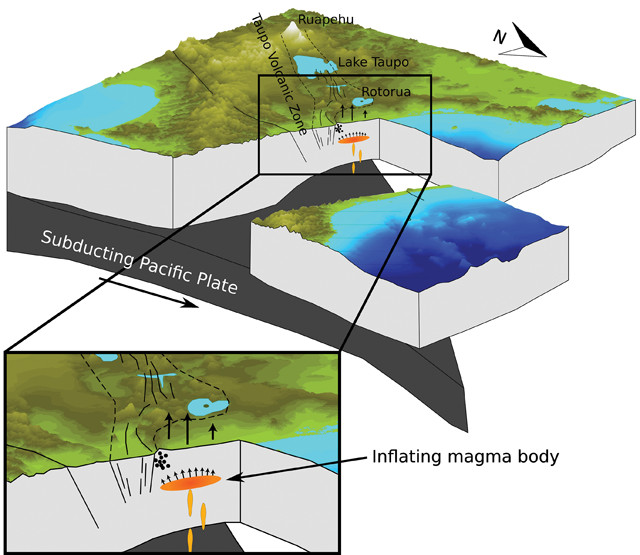
by Lucas Joel Tuesday, October 18, 2016

Subduction of the Pacific Plate under the North Island of New Zealand causes magma upwelling in the Taupo Volcanic Zone (TVZ). Credit: Ian Hamling.
New Zealand is no stranger to volcanism, but a newly discovered magma chamber 9.5 kilometers below the surface was an unexpected find for scientists studying ground movement around the country’s most active volcanic zone. The new chamber doesn’t sit directly beneath New Zealand’s familiar volcanoes, but just north and west of them beneath the Bay of Plenty coast. The find suggests recent intrusions of molten rock into a previously unknown magmatic zone. Researchers led by geophysicist Ian Hamling of GNS Science, a research institute and consulting firm in New Zealand, inferred the chamber’s presence indirectly from measurements of uplift in the Taupo Volcanic Zone (TVZ), which stretches beneath the country’s North Island to just offshore under the Bay of Plenty; the TVZ is where most of New Zealand’s volcanism over the past 1.6 million years has occurred. “The magnitude and spatial pattern of deformation along the Bay of Plenty coast are not consistent with a tectonic origin,” the authors wrote in a new study in Science Advances. “Given the proximity to the active TVZ, we assume that the observed uplift is a result of the accumulation of magma at depth.”
Hamling and his co-authors observed the uplift in radar data from the European Space Agency’s Envisat satellite, which operated from 2002 to 2012, comparing the uplift rate to indications from earlier geodetic surveys. Between 1950 and 1978, about 4 to 5 millimeters of uplift occurred per year. From 2005 to 2011, however, the uplift rate was closer to 12 millimeters per year, indicating a fresh intrusion of magma into the previously unrecognized chamber.
The researchers attributed an earthquake swarm in the region between 2005 and 2009 to the magma surge, and they noted that such swarms could pose risks for the roughly 100,000 inhabitants of Tauranga, about 50 kilometers away from the uplift zone. “Continued monitoring will allow us to identify future pulses of inflation and potentially enable us to predict earthquake swarms in the region,” they wrote.
© 2008-2021. All rights reserved. Any copying, redistribution or retransmission of any of the contents of this service without the expressed written permission of the American Geosciences Institute is expressly prohibited. Click here for all copyright requests.